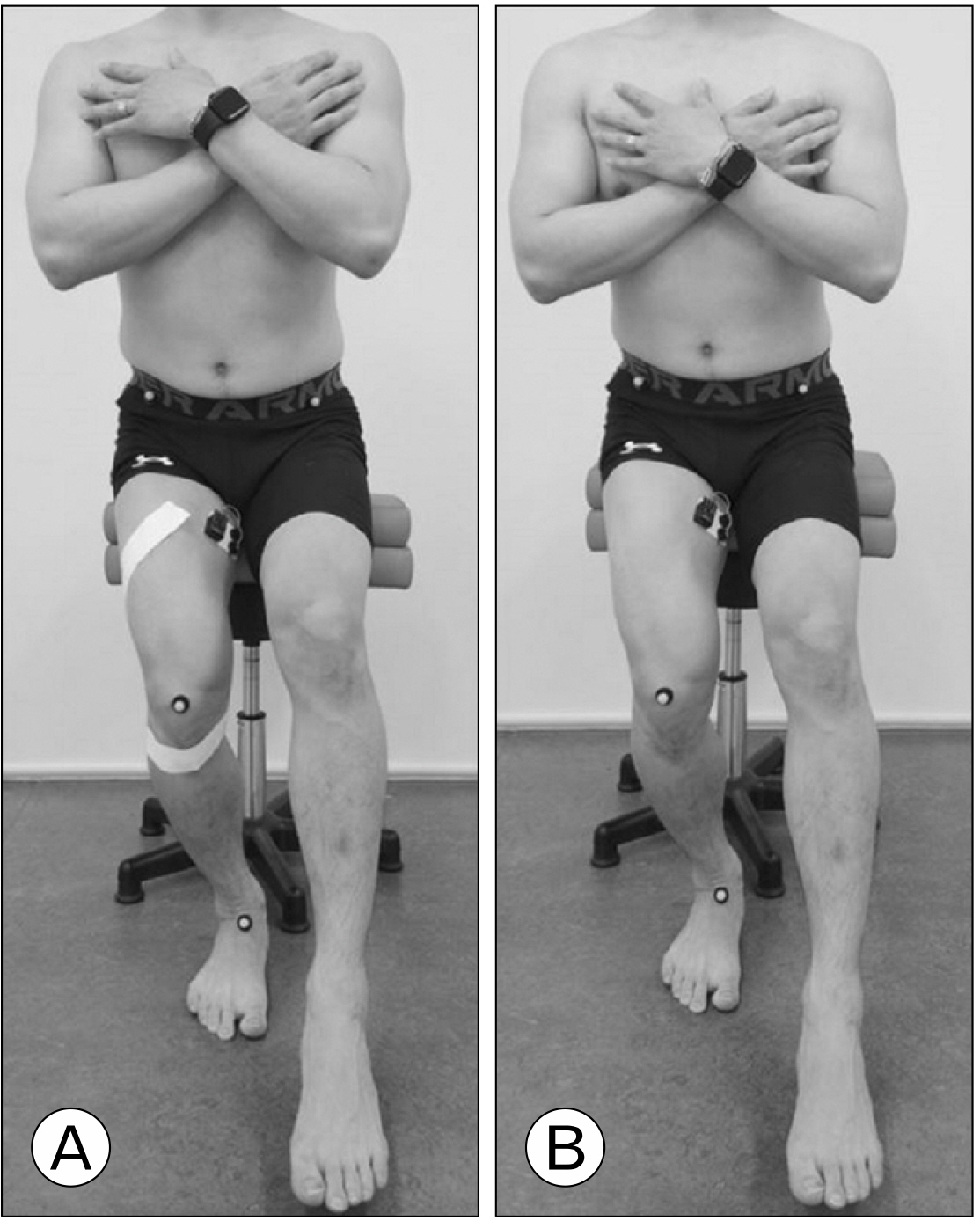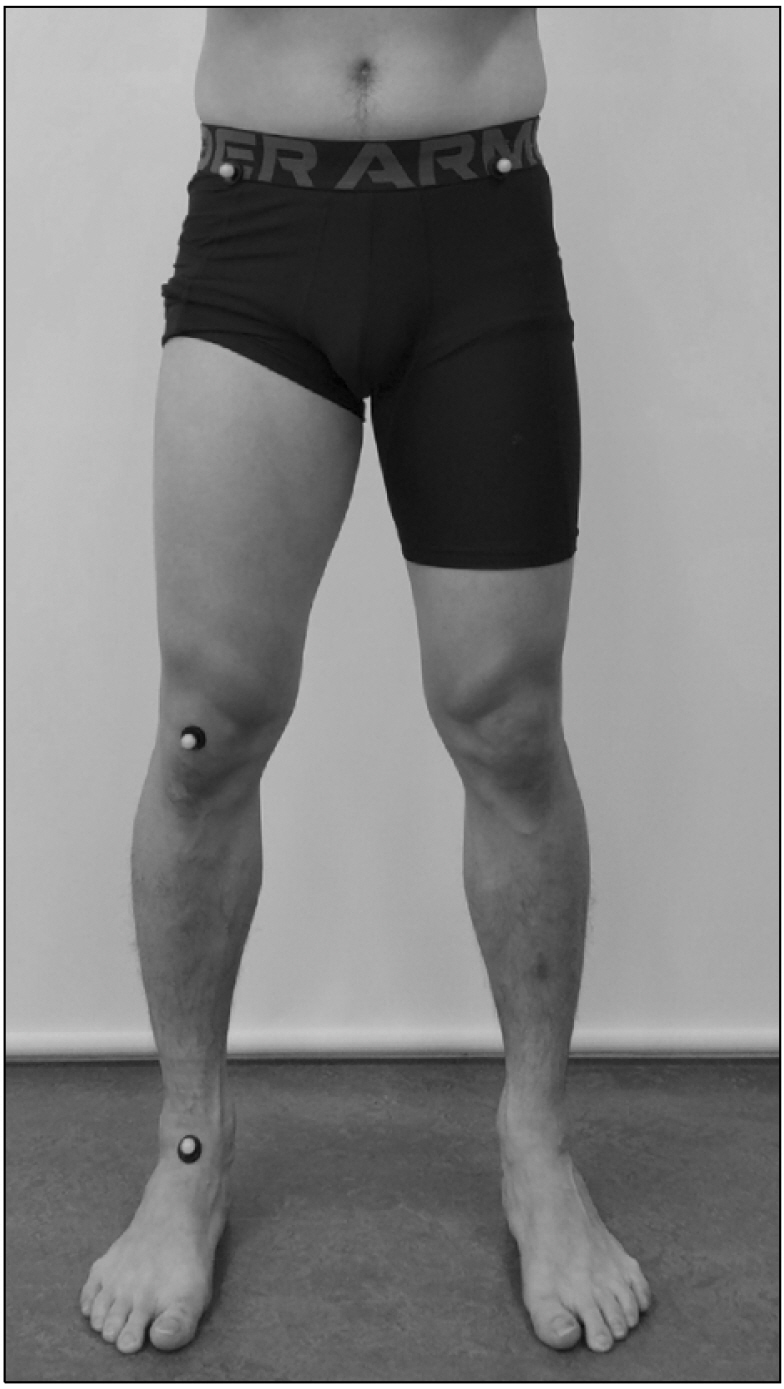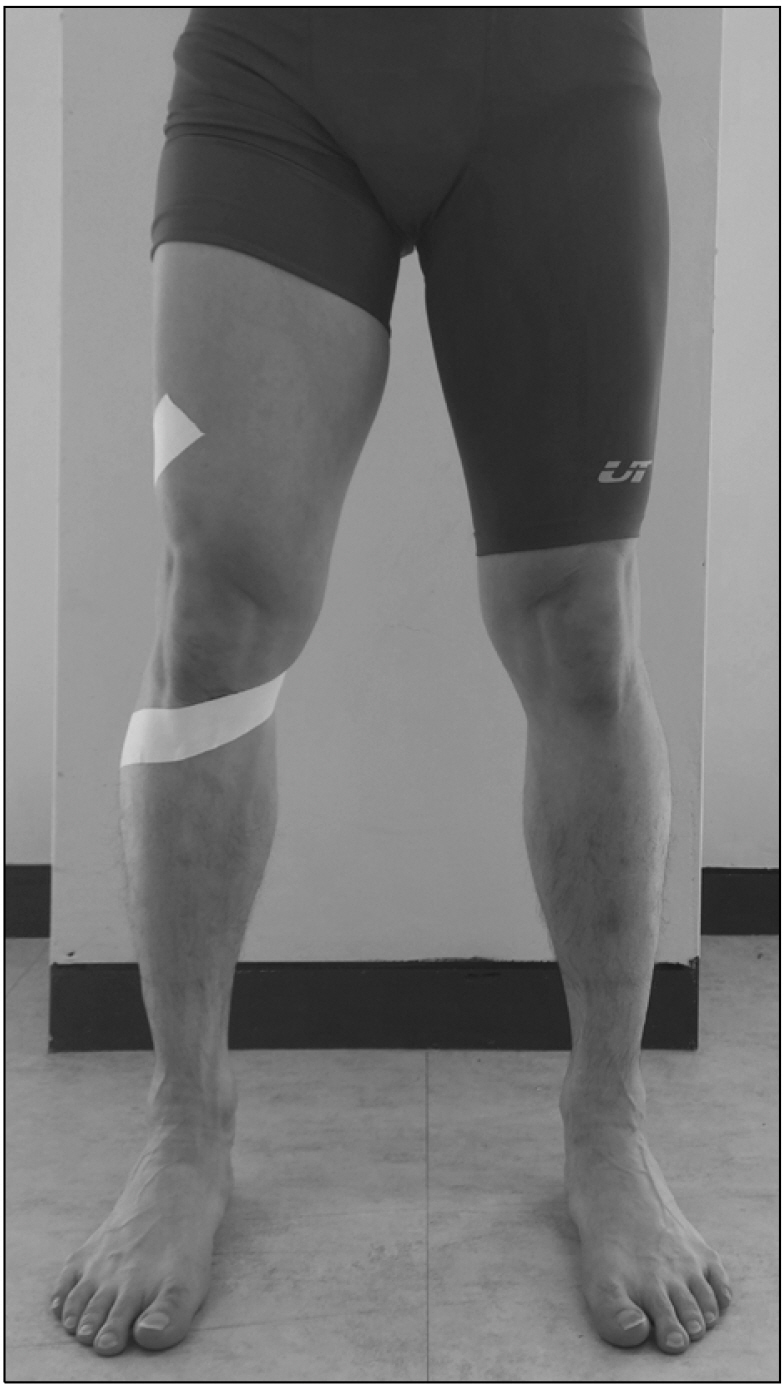Korean J Sports Med.
2023 Dec;41(4):207-215. 10.5763/kjsm.2023.41.4.207.
Analysis of Hip Joint Muscle Activity and Lower Extremity Kinematic Depending on Mulligan Knee Taping Application during Single Leg Squat
- Affiliations
-
- 1Department of Smart Healthcare, Marine Sports Major, Pukyong National University, Busan, Korea
- 2Department of Physical Therapy, Pusan National University Yangsan Hospital, Yangsan, Korea
- KMID: 2548994
- DOI: http://doi.org/10.5763/kjsm.2023.41.4.207
Abstract
- Purpose
This study was aimed to identify the effect of Mulligan knee taping (MKT) application on the hip joint muscle activity and lower extremity kinematic during single leg squat.
Methods
Twenty healthy male partisipants, aged between 19 and 29 years, were measured for hip joint muscle activity, medial knee displacement, and hip adduction angles according to the application of MKT. In single leg squat, the eccentric, isometric, and concentric contraction phases were performed until the knee flexed at a depth of 60°. The muscle activity (unit, %MVIC) of hip joints in each phase and the medial knee displacement (unit, cm) and hip adduction angle (unit, °) were analyzed before and after the application of MKT during single leg squat. All measurements were performed with the dominant leg, and the order of MKT and non-taping was randomly determined by drawing lots.
Results
During single leg squat, the muscle activity of the gluteus maximus muscle in the eccentric and isometric contraction phases significantly increased when MKT was applied than when non-taping (p=0.048 and p=0.012, respectively). There was no statistically significant difference between the muscle activity of other lower extremity muscles and the medial knee displacement and hip adduction angle (p> 0.05).
Conclusion
It was confirmed that the activity of the gluteus maximus muscle increased in the case where single leg squat was performed after applying MKT, compared to the case where it was performed without application. Therefore, MKT application is recommended to increase the muscle activity of the gluteus maximus during single leg squat.
Keyword
Figure
Reference
-
1. Zeller BL, McCrory JL, Kibler WB, Uhl TL. 2003; Differences in kinematics and electromyographic activity between men and women during the single-legged squat. Am J Sports Med. 31:449–56. DOI: 10.1177/03635465030310032101. PMID: 12750142.
Article2. Mann RA, Moran GT, Dougherty SE. 1986; Comparative electromyography of the lower extremity in jogging, running, and sprinting. Am J Sports Med. 14:501–10. DOI: 10.1177/036354658601400614. PMID: 3799879.
Article3. Homan KJ, Norcross MF, Goerger BM, Prentice WE, Blackburn JT. 2013; The influence of hip strength on gluteal activity and lower extremity kinematics. J Electromyogr Kinesiol. 23:411–5. DOI: 10.1016/j.jelekin.2012.11.009. PMID: 23246034.4. Distefano LJ, Blackburn JT, Marshall SW, Padua DA. 2009; Gluteal muscle activation during common therapeutic exercises. J Orthop Sports Phys Ther. 39:532–40. DOI: 10.2519/jospt.2009.2796. PMID: 19574661.
Article5. Ferber R, Davis IS, Hamill J, Pollard CD, McKeown KA. 2002; Kinetic variables in subjects with previous lower extremity stress fractures. Med Sci Sports Exerc. 34:S5. DOI: 10.1097/00005768-200205001-00025.
Article6. Neamatallah Z, Herrington L, Jones R. 2020; An investigation into the role of gluteal muscle strength and EMG activity in controlling HIP and knee motion during landing tasks. Phys Ther Sport. 43:230–5. DOI: 10.1016/j.ptsp.2019.12.008. PMID: 31902735.
Article7. Sims KJ, Brauer SG. 2000; A rapid upward step challenges medio-lateral postural stability. Gait Posture. 12:217–24. DOI: 10.1016/S0966-6362(00)00077-1. PMID: 11154932.
Article8. Aminaka N, Pietrosimone BG, Armstrong CW, Meszaros A, Gribble PA. 2011; Patellofemoral pain syndrome alters neuromuscular control and kinetics during stair ambulation. J Electromyogr Kinesiol. 21:645–51. DOI: 10.1016/j.jelekin.2011.03.007. PMID: 21524921.
Article9. Dawson SJ, Herrington L. 2015; Improving single-legged-squat performance: comparing 2 training methods with potential implications for injury prevention. J Athl Train. 50:921–9. DOI: 10.4085/1062-6050-50.9.03. PMID: 26308498. PMCID: PMC4639882.
Article10. Palmer K, Hebron C, Williams JM. 2015; A randomised trial into the effect of an isolated hip abductor strengthening programme and a functional motor control programme on knee kinematics and hip muscle strength. BMC Musculoskelet Disord. 16:105. DOI: 10.1186/s12891-015-0563-9. PMID: 25935843. PMCID: PMC4424529.
Article11. Sasaki S, Tsuda E, Yamamoto Y, et al. 2019; Core-muscle training and neuromuscular control of the lower limb and trunk. J Athl Train. 54:959–69. DOI: 10.4085/1062-6050-113-17. PMID: 31386583. PMCID: PMC6795098.
Article12. Kim HH, Kim KH. 2021; Effects of Kinesio taping with squat exercise on the muscle activity, muscle strength, muscle tension, and dynamic stability of softball players in the lower extremities: a randomized controlled study. Int J Environ Res Public Health. 19:276. DOI: 10.3390/ijerph19010276. PMID: 35010536. PMCID: PMC8751181.
Article13. Saki F, Romiani H, Ziya M, Gheidi N. 2022; The effects of gluteus Medius and tibialis anterior Kinesio taping on postural control, knee kinematics, and knee proprioception in female athletes with dynamic knee valgus. Phys Ther Sport. 53:84–90. DOI: 10.1016/j.ptsp.2021.11.010. PMID: 34875529.
Article14. Hing W, Hall T, Rivett D, Vicenzino B, Mulligan B. The Mulligan concept of manual therapy (eBook): textbook of techniques. Elsevier Health Sciences;2014.15. Mulligan BR. Manual therapy: "NAGS", "SNAGS", "MWMS" etc. 5th ed. Plane View Services Ltd., distributed by Orthopedic Physical Therapy Products;2006.16. Hickey A, Hopper D, Hall T, Wild CY. 2016; The effect of the Mulligan Knee taping technique on patellofemoral pain and lower limb biomechanics. Am J Sports Med. 44:1179–85. DOI: 10.1177/0363546516629418. PMID: 26903215.
Article17. Mackay GJ, Stearne SM, Wild CY, et al. 2020; Mulligan knee taping using both elastic and rigid tape reduces pain and alters lower limb biomechanics in female patients with patellofemoral pain. Orthop J Sports Med. 8:2325967120921673. DOI: 10.1177/2325967120921673. PMID: 32528991. PMCID: PMC7263138.
Article18. Diniz KM, Resende RA, Mascarenhas RO, Silva HJ, Filho RG, Mendonça LM. 2021; Hip passive stiffness is associated with hip kinematics during single-leg squat. J Bodyw Mov Ther. 28:68–74. DOI: 10.1016/j.jbmt.2021.06.008. PMID: 34776202.
Article19. Callaghan MJ, Selfe J, McHenry A, Oldham JA. 2008; Effects of patellar taping on knee joint proprioception in patients with patellofemoral pain syndrome. Man Ther. 13:192–9. DOI: 10.1016/j.math.2006.11.004. PMID: 17296323.
Article20. Mauntel TC, Begalle RL, Cram TR, et al. 2013; The effects of lower extremity muscle activation and passive range of motion on single leg squat performance. J Strength Cond Res. 27:1813–23. DOI: 10.1519/JSC.0b013e318276b886. PMID: 23096063.
Article21. Jaberzadeh S, Yeo D, Zoghi M. 2016; The effect of altering knee position and squat depth on VMO : VL EMG ratio during squat exercises. Physiother Res Int. 21:164–73. DOI: 10.1002/pri.1631. PMID: 25962352.
Article22. Olivier B, Quinn SL, Benjamin N, Green AC, Chiu J, Wang W. 2019; Single-leg squat delicacies: the position of the nonstance limb is an important consideration. J Sport Rehabil. 28:318–24. DOI: 10.1123/jsr.2018-0181. PMID: 30426818.23. Khuu A, Loverro KL, Lewis CL. 2022; Muscle activation during single-legged squat is affected by position of the nonstance limb. J Athl Train. 57:170–6. DOI: 10.4085/1062-6050-0019.21. PMID: 33887761. PMCID: PMC8876880.
Article24. Dingenen B, Malfait B, Vanrenterghem J, Verschueren SM, Staes FF. 2014; The reliability and validity of the measurement of lateral trunk motion in two-dimensional video analysis during unipodal functional screening tests in elite female athletes. Phys Ther Sport. 15:117–23. DOI: 10.1016/j.ptsp.2013.05.001. PMID: 23891143.
Article25. Kim HS, Yoo HI, Hwang UJ, Kwon OY. 2021; Comparison of dynamic knee valgus during single-leg step down between people with and without pronated foot using two-dimensional video analysis. Phys Ther Korea. 28:266–72. DOI: 10.12674/ptk.2021.28.4.266.
Article26. Ban R, Yang F. 2022; Preliminary study on acute effects of an intervention to increase dorsiflexion range of motion in reducing medial knee displacement. Clin Biomech (Bristol, Avon). 95:105637. DOI: 10.1016/j.clinbiomech.2022.105637. PMID: 35421666.
Article27. Cram JR, Kasman GS, Holtz J. Introduction to surface electromyography. Aspen Publishers;1998.28. Selkowitz DM, Beneck GJ, Powers CM. 2013; Which exercises target the gluteal muscles while minimizing activation of the tensor fascia lata?: electromyographic assessment using fine-wire electrodes. J Orthop Sports Phys Ther. 43:54–64. DOI: 10.2519/jospt.2013.4116. PMID: 23160432.
Article29. Lee JH, Cynn HS, Kwon OY, et al. 2014; Different hip rotations influence hip abductor muscles activity during isometric side-lying hip abduction in subjects with gluteus Medius weakness. J Electromyogr Kinesiol. 24:318–24. DOI: 10.1016/j.jelekin.2014.01.008. PMID: 24560168.
Article30. Krommes K, Bandholm T, Jakobsen MD, et al. 2017; Dynamic hip adduction, abduction and abdominal exercises from the holmich groin-injury prevention program are intense enough to be considered strengthening exercises: a cross-sectional study. Int J Sports Phys Ther. 12:371–80.31. Someeh M, Norasteh AA, Daneshmandi H, Asadi A. 2015; Immediate effects of Mulligan's fibular repositioning taping on postural control in athletes with and without chronic ankle instability. Phys Ther Sport. 16:135–9. DOI: 10.1016/j.ptsp.2014.08.003. PMID: 25165014.
Article32. Kim SY, Kang MH. 2021; The influences of restricted compensatory movement on activation pattern of gluteal muscles during unilateral weight-bearing exercise. J Hum Sport Exerc. 16:618–26. DOI: 10.14198/jhse.2021.163.11.
Article33. Crossley KM, Zhang WJ, Schache AG, Bryant A, Cowan SM. 2011; Performance on the single-leg squat task indicates hip abductor muscle function. Am J Sports Med. 39:866–73. DOI: 10.1177/0363546510395456. PMID: 21335344.
Article
- Full Text Links
- Actions
-
Cited
- CITED
-
- Close
- Share
- Similar articles
-
- Comparison of Lower Extremity Muscle Activity during the Deep Squat Exercise Using Various Tools
- Kinetic Analysis of Crouching Start Depending on Taping Applied to Hamstring in Elite Male Sprinters
- Activity of the Quadriceps during Semisquat and Squat Exercises with Isometric Hip Adduction and Abduction in Young Healthy Persons
- Immediate Effect of Calf Muscle Kinesio Taping on Ankle Joint Reposition Sense and Force Sense in Healthy Elderly
- Effects of Auditory Information and Expertise on the Kinematic Variables of Lower Extremity during Golf Iron Swing






